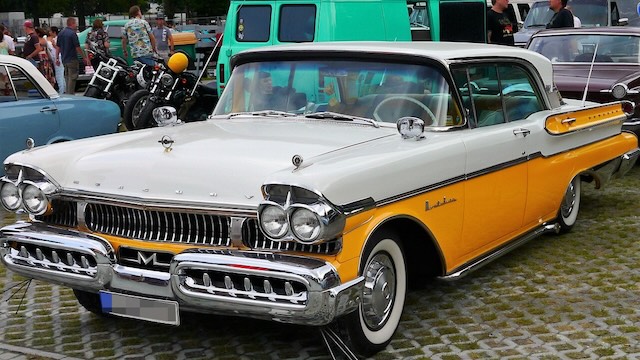According to one web site, “you can expect a standard car to last around 12 years or about 200,000 miles.” Another site agrees, “The average car lasts around 12 years or around 200,000 miles.” Both of these web sites are wrong.
A 1957 Mercury Montclair, made during the gaudiest era of U.S. automotive design.
This caught my attention when I was reading the MBTA’s State-of-Good-Repair report, which tried to explain Boston transit’s state of poor repair simply as a function of age, and not the agency’s own incompetence. It did so by using cars as an example, claiming that the “useful life” of a car was eight years and anything older than that was in a “state of bad repair.”
That might have been more persuasive if it had been written back in 1969, when the average automobile on the road was just 5.1 years old according to the Nationwide Personal Transportation Survey. As of 2022, the average automobile is 12.2 years old and the average car is 13.1 years old according to a motor vehicle survey by Standard and Poors. (You can see the trends over time in this table published by the Bureau of Transportation Statistics.)
The web pages cited in the first paragraph above must have read this number and equated “expected life” with “average age.” The S&P survey noted that there were 283 million vehicles on the road in 2022, while a report from the St. Louis Fed indicates that 191 million vehicles had been sold in the previous 12 years. That means that almost 100 million automobiles were older than 12 years, and some must have been a lot older if the overall average was 12.2 years.
Of course, what the MBTA failed to acknowledge is something that most car owners know: vehicles last a lot longer if they are well maintained. One 52-year-old car had been driven more than 3.2 million miles and outlived its owner. While this is an extreme, it is likely that 20 years is a more reasonable expected life span than 8.
The main point here is that it was MBTA’s lack of maintenance, and not just the age of its system, that led to its $24.5 billion state-of-good-repair backlog. But a secondary point is that anyone who bases the cost of driving on a claim that cars are only expected to last 8 or 10 years is simply exaggerating that cost.









From Railway Age …
At the end of 2019, the locomotive fleet totaled 39,125, down 393 units from 2018.
The average age increased 0.7 years, to 27.3 years, and the median age increased 0.2 years, to 23.0 years. This was the 10th consecutive year the average and median ages increased.
https://www.railwayage.com/mechanical/locomotives/steady-state/
Where I live, the biggest killer of automobiles was NaCl (salt) used to treat snow and ice covered roads in states that suffer from snow and freezing rain in the winter. Better designs and materials have reduced the speed of NaCl induced corrosion in recent years.
OVer years GM and Ford and the like improved Hydroformed hard press steel. This is some extremely tough stuff.
Modern coatings to protect the steel.
The issue with high speed rail and rail transit systems is their dedicated infrastructure requirements they need dedicated track, which is incompatible with other rail systems you cant move freight on a transit subway line or HSR line. And it needs electric power supply cables, basically an electric grid.
High speed rail is a notorious money pit everywhere it’s fielded. It does require dedicated infrastructure across the entire length of the route and is surely expensive over course not to mention maintenance of leaving the infrastructure outside in horrendous environmental conditions. That’s why companies like Mitsubishi and Euro manufacturers who build trains and train propulsion systems are so adamant but lazy about self propelled trains is to avoid the infrastructure costs. If you can eliminate pantograph or third rail, that’s infrastructure cost you don’t have to spend. Since their money comes from infrastructure spending, more infrastructure is their business model.
Where as GE and Siemens are very adamant of building locomotives. High speed and passenger rails have huge cost disadvantage namely because the track and electric power are both critical infrastructure to run the train. By contrast the US freight trains are diesel powered. A locomotive regardless of power is cost efficient. Whether it runs on diesel, gasoline, steam power, hydrogen internal combustion or fuel cells or electricity In a battery. Because the technology is in the VEHICLE instead of the infrastructure anything that happens to infrastructure (such as Neglect, deferred maintenance or accidents) brings the whole system to its knees. As long as gauge requirements are met, a diesel locomotive can run.
The analogy makes some sense. It really should be a function of mileage, not years. After all a maintenance backlog means you’re not doing things to properly maintain it.
Skipping oil changes, not replacing a bad shock, etc cause – or will cause down the line – more problems.
Age isn’t the issue, build quality and abuse is.
People say ford trucks are junk. But every time on sale they have 79,100 200 thousand miles…..cuz original owners used them for work. They still run.
How long do electric cars last? You don’t see many used electric cars for sale. Or old ones on the road.
Total global sales of Tesla model S, since 2012…
263,000 units.
11 years and only 263000 units, they may last a good long time structurally, but if the battery needs replacing, safe bet to simply decommission